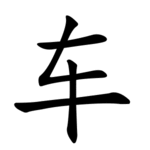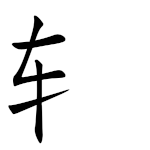Radical 159
In this article, we will explore the topic of Radical 159 from different perspectives and angles, with the aim of providing the reader with a comprehensive and complete vision of this topic that is so relevant today. We will analyze its impact in different areas of daily life, as well as its implications at a global level. Through an exhaustive analysis, we will try to unravel its causes, consequences and possible solutions, providing relevant data and scientific evidence that support our arguments. Likewise, we will rely on the opinion of experts in the field to enrich the discussion and offer a broad and enriching vision about Radical 159. Read on to delve deeper into this fascinating topic!
| 車 | ||
|---|---|---|
| ||
| 車 (U+8ECA) "cart, car" | ||
| Pronunciations | ||
| Pinyin: | chē | |
| Bopomofo: | ㄔㄜ | |
| Wade–Giles: | ch'e1 | |
| Cantonese Yale: | che1, geui1 | |
| Jyutping: | ce1, geoi1 | |
| Japanese Kana: | シャ sha (on'yomi) くるま kuruma (kun'yomi) | |
| Sino-Korean: | 거 geo | |
| Hán-Việt: | xa, xe, xế | |
| Names | ||
| Chinese name(s): | (Left) 車字旁/车字旁 chēzìpáng (Bottom) 車字底/车字底 chēzìdǐ | |
| Japanese name(s): | 車/くるま kuruma 車偏/くるまへん kurumahen | |
| Hangul: | 수레 sure | |
| Stroke order animation | ||
 | ||


Radical 159 or radical cart (車部) meaning "cart" or "car" is one of the 20 Kangxi radicals (214 radicals in total) composed of 7 strokes.
In the Kangxi Dictionary, there are 361 characters (out of 49,030) to be found under this radical.
车, the simplified form of 車, is the 68th indexing component in the Table of Indexing Chinese Character Components predominantly adopted by Simplified Chinese dictionaries published in mainland China, while the traditional form 車 is listed as its associated indexing components. 车 is derived from the cursive form of 車.
Evolution
-
Oracle bone script character
-
Bronze script character
-
Large seal script character
-
Small seal script character
Derived characters
| Strokes | Characters (車) | Characters (车) |
|---|---|---|
| +0 | 車 | 车SC (=車) |
| +1 | 軋 | 轧SC (=軋) |
| +2 | 軌 軍 轨SC (=軌) | |
| +3 | 軎 (=轊) 軏 軐 軑 軒 軓 軔 軕 | 轩SC (=軒) 轪SC (=軑) 轫SC (=軔) |
| +4 | 軖 軗 軘 軙 軚 軛 軜 軝 軞 軟 軠 軡 転JP (=轉) 軣JP nonstandard (=轟) | 转SC (=轉) 轭SC (=軛) 轮SC (=輪) 软SC (=軟) 轰SC (=轟) |
| +5 | 軤 軥 軦 軧 軨 軩 軪 軫 軬 軮 軯 軰 軱 軲 軳 軴 軵 軶 (=軛) 軷 軸 軹 軺 軻 軼 軽JP (=輕; also variant form of 輊) | 轱SC (=軲) 轲SC (=軻) 轳SC (=轤) 轴SC (=軸) 轵SC (=軹) 轶SC (=軼) 轷SC (=軤) 轸SC (=軫) 轹SC (=轢) 轺SC (=軺) 轻SC (=輕) |
| +6 | 軭 軾 軿 輀 輁 輂 較 輄 輅 輆 輇 輈 載 輊 輋 輌JP (=輛) | 轼SC (=軾) 载SC (=載) 轾SC (=輊) 轿SC (=轎) 辀SC (=輈) 辁SC (=輇) 辂SC (=輅) 较SC (=較) |
| +7 | 輍 輎 輏 輐 輑 輒 輓 輔 輕 | 辄SC (=輒) 辅SC (=輔) 辆SC (=輛) |
| +8 | 輖 輗 輘 輙 (=輒) 輚 輛 輜 輝 輞 輟 輠 輡 輢 輣 輤 輥 輦 輧 輨 輩 輪 輫 輬 | 辇SC (=輦) 辈SC (=輩) 辉SC (=輝) 辊SC (=輥) 辋SC (=輞) 辌SC (=輬) 辍SC (=輟) 辎SC (=輜) |
| +9 | 輭 (=軟) 輮 輯 輰 輱 輲 輳 輴 輵 輶 輷 輸 輹 輺 (=輜) 輻 輼HK/GB TC (=轀) | 辏SC (=輳) 辐SC (=輻) 辑SC (=輯) 辒SC (=轀) 输SC (=輸) 辔SC (=轡) |
| +10 | 輽 (=軬) 輾 輿 轀 轁 轂 轃 轄 轅 | 辕SC (=轅) 辖SC (=轄) 辗SC (=輾) |
| +11 | 轆 轇 轈 轉 轊 轋 轌 | 辘SC (=轆) |
| +12 | 轍 轎 轏 轐 轑 轒 轓 轔 | 辙SC (=轍) 辚SC (=轔) |
| +13 | 轕 轖 轗 轘 轙 轚 | |
| +14 | 轛 轜 轝 轞 轟 | |
| +15 | 轠 轡 轢 | |
| +16 | 轣 轤 | |
| +20 | 轥 |
Sinogram
The radical is also used as an independent Chinese character. It is one of the Kyōiku kanji or Kanji taught in elementary school in Japan. It is a first grade kanji
References
- ^ "Unihan data for U+8ECA". Unicode Consortium. Retrieved 26 March 2011.
- ^ a b "The Kyoiku Kanji (教育漢字) - Kanshudo". www.kanshudo.com. Archived from the original on March 24, 2022. Retrieved 2023-05-06.
Literature
- Fazzioli, Edoardo (1987). Chinese calligraphy : from pictograph to ideogram : the history of 214 essential Chinese/Japanese characters. calligraphy by Rebecca Hon Ko. New York: Abbeville Press. ISBN 0-89659-774-1.



